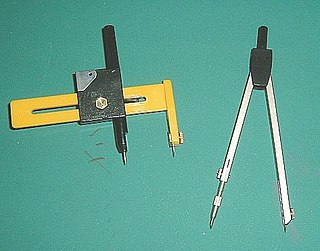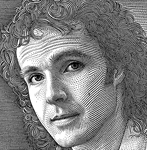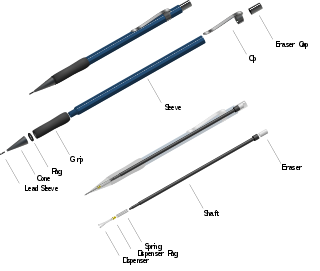
A ballpoint pen, also known as a biro, ball pen, or dot pen, is a pen that dispenses ink over a metal ball at its point, i.e. over a "ball point". The metal commonly used is steel, brass, or tungsten carbide. The design was conceived and developed as a cleaner and more reliable alternative to dip pens and fountain pens, and it is now the world's most-used writing instrument; millions are manufactured and sold daily. It has influenced art and graphic design and spawned an artwork genre.

Drawing is a visual art that uses an instrument to mark paper or another two-dimensional surface. The instrument might be pencils, crayons, pens with inks, brushes with paints or combinations of these, and in more modern times, computer styluses with graphics tablets.

An adjustable spanner, shifting spanner or adjustable wrench is any of various styles of spanner (wrench) with a movable jaw, allowing it to be used with different sizes of fastener head rather than just one fastener size, as with a conventional fixed spanner.

A drawing board is, in its antique form, a kind of multipurpose desk which can be used for any kind of drawing, writing or impromptu sketching on a large sheet of paper or for reading a large format book or other oversized document or for drafting precise technical illustrations. The drawing table used to be a frequent companion to a pedestal desk in a study or private library, during the pre-industrial and early industrial era.

A fountain pen is a writing instrument which uses a metal nib to apply a water-based ink to paper. It is distinguished from earlier dip pens by using an internal reservoir to hold ink, eliminating the need to repeatedly dip the pen in an inkwell during use. The pen draws ink from the reservoir through a feed to the nib and deposits the ink on paper via a combination of gravity and capillary action. Filling the reservoir with ink may be achieved manually, via the use of an eyedropper or syringe, or via an internal filling mechanism which creates suction or a vacuum to transfer ink directly through the nib into the reservoir. Some pens employ removable reservoirs in the form of pre-filled ink cartridges.

A pen is a common writing instrument that applies ink to a surface, usually paper, for writing or drawing. Early pens such as reed pens, quill pens, dip pens and ruling pens held a small amount of ink on a nib or in a small void or cavity which had to be periodically recharged by dipping the tip of the pen into an inkwell. Today, such pens find only a small number of specialized uses, such as in illustration and calligraphy. Reed pens, quill pens and dip pens, which were used for writing, have been replaced by ballpoint pens, rollerball pens, fountain pens and felt or ceramic tip pens. Ruling pens, which were used for technical drawing and cartography, have been replaced by technical pens such as the Rapidograph. All of these modern pens contain internal ink reservoirs, such that they do not need to be dipped in ink while writing.

A compass, more accurately known as a pair of compasses, is a technical drawing instrument that can be used for inscribing circles or arcs. As dividers, it can also be used as a tool to mark out distances, in particular, on maps. Compasses can be used for mathematics, drafting, navigation and other purposes.

Hedcut is a term referring to a style of drawing, associated with The Wall Street Journal half-column portrait illustrations. They use the stipple method of many small dots and the hatching method of small lines to create an image, and are designed to emulate the look of woodcuts from old-style newspapers, and engravings on certificates and currency. The phonetic spelling of "hed" may be based on newspapers' use of the term hed for "headline."

A mechanical pencil, also clutch pencil, is a pencil with a replaceable and mechanically extendable solid pigment core called a "lead". The lead, often made of graphite, is not bonded to the outer casing, and can be mechanically extended as its point is worn away as it is being used. The vast majority of mechanical pencils have erasers.

A go/no-go gauge refers to an inspection tool used to check a workpiece against its allowed tolerances via a go/no-go test. Its name is derived from two tests: the check involves the workpiece having to pass one test (go) and fail the other (no-go).
Joseph Clement Coll was an American book and newspaper illustrator. He was known for his pen and ink story illustrations that were used to illustrate adventure stories such as Conan Doyle's Sir Nigel.
In computer graphics, image tracing, raster-to-vector conversion or raster vectorization is the conversion of raster graphics into vector graphics.

Rotring is a former German manufacturing company of technical drawing tools and writing implements. Established in 1928 as a fountain pen manufacturer, Rotring is currently a brand owned by Newell Brands after its acquisition in 1998. The name "Rotring" directly translates to "red ring" which is still placed around the barrel of their pens today. The company's name was changed to Rotring in the early 1970s to match the trademark.

A technical pen is a specialized instrument used by an engineer, architect, or drafter to make lines of constant width for architectural, engineering, or technical drawings. "Rapidograph" is a trademarked name for one type of technical pen. Technical pens use either a refillable ink reservoir or a replaceable ink cartridge.
A beam compass is a compass with a beam and sliding sockets or cursors for drawing and dividing circles larger than those made by a regular pair of compasses. The instrument can be as a whole, or made on the spot with individual sockets and any suitable beam.

An architectural drawing or architect's drawing is a technical drawing of a building that falls within the definition of architecture. Architectural drawings are used by architects and others for a number of purposes: to develop a design idea into a coherent proposal, to communicate ideas and concepts, to convince clients of the merits of a design, to assist a building contractor to construct it based on design intent, as a record of the design and planned development, or to make a record of a building that already exists.

Drafting tools may be used for measurement and layout of drawings, or to improve the consistency and speed of creation of standard drawing elements. Tools such as pens and pencils mark the drawing medium. Other tools such as straight edges, assist the operator in drawing straight lines, or assist the operator in drawing complicated shapes repeatedly. Various scales and the protractor are used to measure the lengths of lines and angles, allowing accurate scale drawing to be carried out. The compass is used to draw arcs and circles. A drawing board was used to hold the drawing media in place; later boards included drafting machines that sped the layout of straight lines and angles. Tools such as templates and lettering guides assisted in the drawing of repetitive elements such as circles, ellipses, schematic symbols and text. Other auxiliary tools were used for special drawing purposes or for functions related to the preparation and revision of drawings. The tools used for manual technical drawing have been displaced by the advent of computer-aided drawing, drafting and design (CADD).

Since their invention and subsequent proliferation in the mid-20th century, ballpoint pens have proven to be a versatile art medium for professional artists as well as amateur doodlers. Ballpoint pen artwork created over the years have been favorably compared to art created using traditional art mediums. Low cost, availability, and portability are cited by practitioners as qualities which make this common writing tool a convenient, alternative art supply.
















